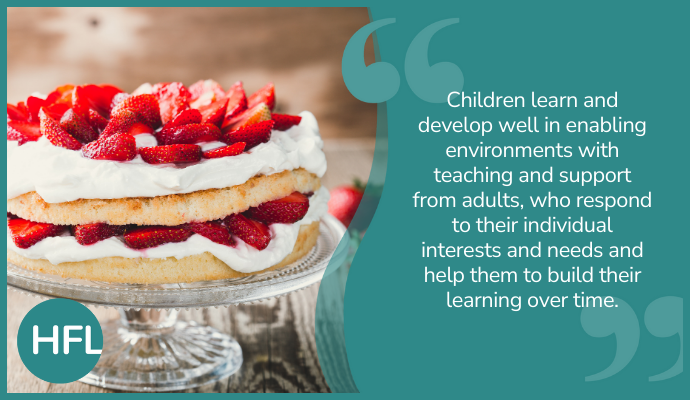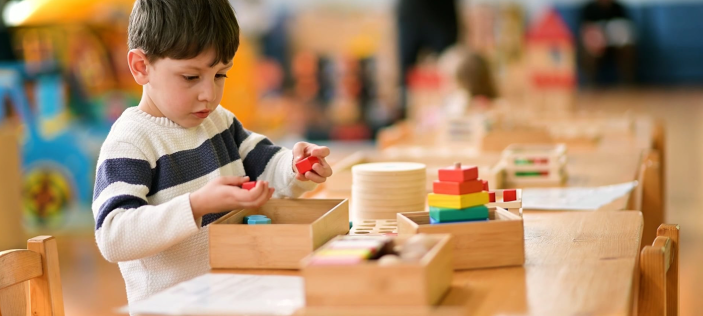
The design of your curriculum identifies the sequenced programme of ambitious, rich, and varied knowledge, skills and concepts that you believe are important for your children to learn and develop. But what role does the EYFS environment play in supporting the effective implementation of your curriculum intent and how can you ensure that you are utilising it to its full potential to maximise children’s outcomes?

Allow me to begin by sharing a personal experience of late that inspired the content of this blog. While watching a popular bakery programme, and aware of the impending birthday celebration of a close family member, I decided it was time to challenge myself. “I could do that…” I thought, as I watched the contestants construct an elaborate cake tower. No more pre-prepared sponge that I had often tried, and failed, to pass off as my own. It was time for me to take the plunge and bake my own cake. Now this may not seem like a ground-breaking decision to some, but for me, this was a personal challenge (believe me when I say my culinary skills leave much to be desired). But, in the knowledge that taking risks enables us to grow and develop, I decided it was time to realise my creative potential and try something new. The excitement of accomplishing a meaningful, personal challenge motivated me and I was fully invested.
On arriving to my local supermarket, I headed straight to the home baking aisle. The ingredients I had planned to use were nowhere to be seen. I searched around the store, frantically trying to locate the essential ingredients, which became increasingly challenging with the absence of clear, accurate signage. Eventually, I came across the sugar, however found this to be stored on the highest shelf of the aisle, ever so slightly out of my reach. On failing to locate a member of staff to assist me, I moved on to the next ingredient on the list: gluten-free flour. The horror at finding the empty space on the shelf where said flour should have been. Without this crucial ingredient, there was no way I could fulfil my goal. All those opportunities to develop my independence and creativity, learn a new skill, set my own goals, build my confidence and take pride in my own accomplishments. Gone. Feeling deflated, I selected a pre-made Victoria sponge, one I had selected many times before, and headed for the checkout.
The role of the environment
“I thought this was a blog about enabling environments”, I hear you cry! As I stood solemnly waiting my turn at the checkout, I began to wonder what could have been. If only the shelves had been organised in a way that ingredients were accessible to me, easy to reach and clearly labelled so that I knew exactly where to find them. If only the shelves had been restocked so that the ingredients that I required to meet my personal needs were available. If only a member of staff had been on hand to sensitively support and guide me so that I could lead with my own ideas. If only the supermarket environment had enabled me to take on this new challenge and learn something new, then, perhaps, I could have realised my baking potential.
This leads us to consider the value of the EYFS environment in supporting the effective implementation of our curriculum and enabling our children to succeed in reaching the goals and ambitions we have designed, as well as those that they set for themselves. While it would have been possible for me to take myself to another supermarket to locate the resources that I needed to achieve my goal, our children do not have this privilege. We understand the significant influence of children’s experiences within their first five years on their future success and, with only 190 days in the school year to have that crucial impact, it is essential that we make every moment count for our children.
“There are three teachers of children: adults, other children, and their physical environment.”
Loris Malaguzzi
Often likened to the ‘third teacher’ (Loris Malguzzi), a high-quality learning environment is a fundamental aspect of early years pedagogy in providing high-quality teaching and learning. It is crucial that we provide children with the right foundations and support to enable them to fulfil their potential. This is achieved by carefully planning an environment that enables children to develop connections with the world around them, with themselves and others, as well as engage in opportunities to practise, revisit and consolidate prior learning, explore, take risks and solve problems. Creating the right physical and emotional environment to enable and facilitate learning is key to children’s growth and development. Therefore, we must ensure that the environment provides the resources, space, and freedom to enable children to follow their own intentions and experience the satisfaction of meeting their own goals.
A recipe for success: Top Tips to consider for creating an Effective Enabling Environment

Accessibility
“Children cannot become independent learners if they can’t see, select and access their own equipment and resources”
(‘Foundations for Independence’, Featherstone and Bayley).
In order to build children’s independence and develop their sense of autonomy, the environment must be well-organised, readily available and accessible so that children know where materials and resources are to support their play.
- are resources stored appropriately, well-organised and clearly labelled so that children can see, reach and access them freely?
- have practitioners explicitly modelled to children how to access, use and tidy away resources independently?
- does your environment invite opportunities for learning across all areas of development?
Challenge
Resources should be carefully planned in response to ongoing assessment to ensure they present appropriate challenge and opportunities for skill progression. “If we constantly provide the same (often basic/emergent) resources, then we encourage children to revisit the same basic/emergent skills” (Alistair Bryce-Clegg). Therefore, as the developmental needs and stages of your cohort emerge and develop over the year, so too should the resources available within your continuous provision.
- have resources been carefully planned in line with current assessment of children’s attainment?
- are resources stimulating, interesting and encourage open-ended exploration and play?
Sense of belonging
It is crucial for children to see themselves, their family and community and their interests represented within the environment, to motivate their engagement and build a strong sense of belonging. This is particularly important in supporting our most disadvantaged and vulnerable children to build connections, uphold a positive self-image and develop a strong sense of self-belief.
“As children become disconnected their status, sense of belonging and self-esteem diminishes, encouraging retreat”
(Dan Nicholls).
- do children see positive representations of themselves and their families reflected within the environment?
- does the environment encourage children to build connections with their own identity? Does it reflect and nurture the individual experiences, fountains of knowledge and interests of each unique child?


